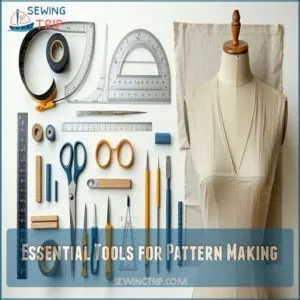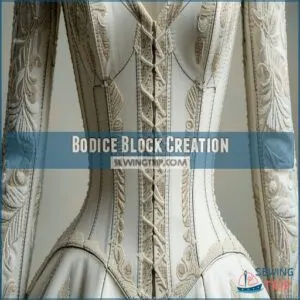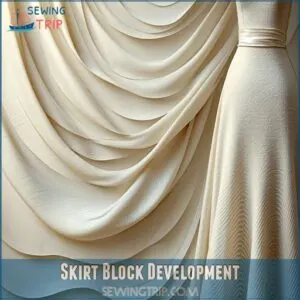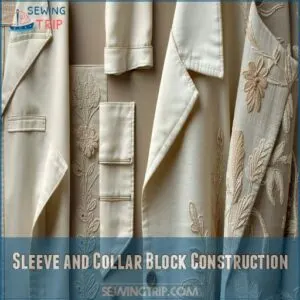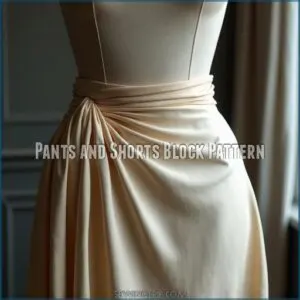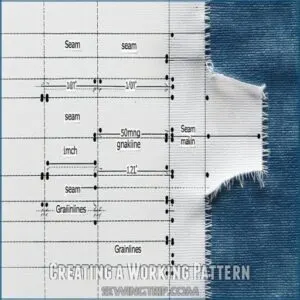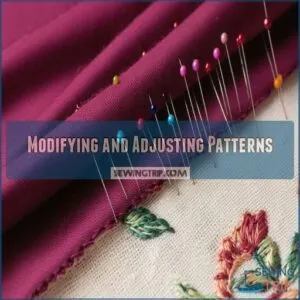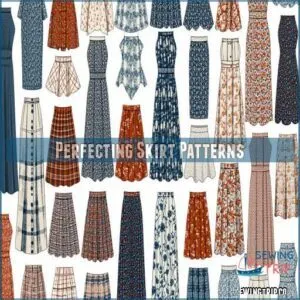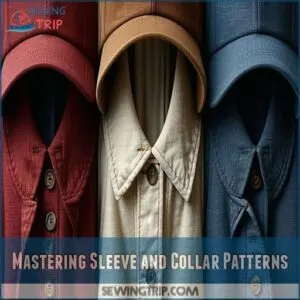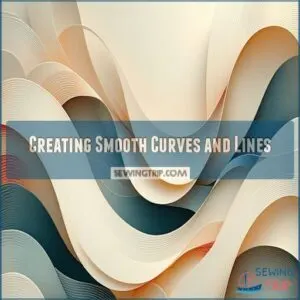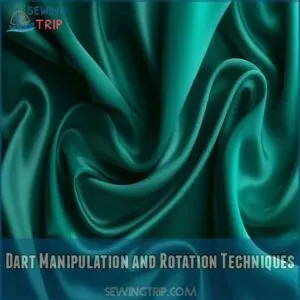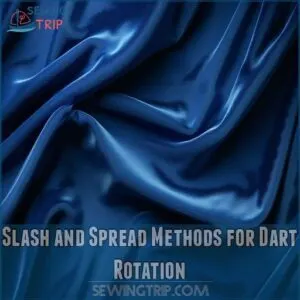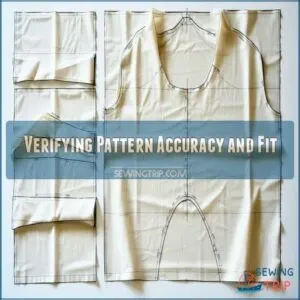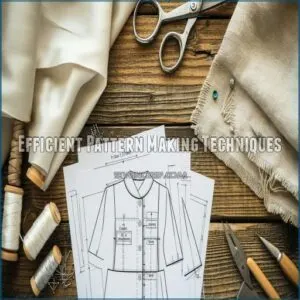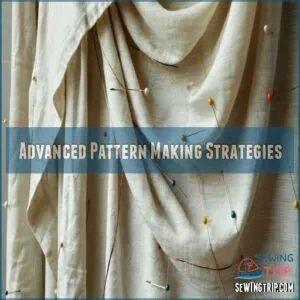This site is supported by our readers. We may earn a commission, at no cost to you, if you purchase through links.
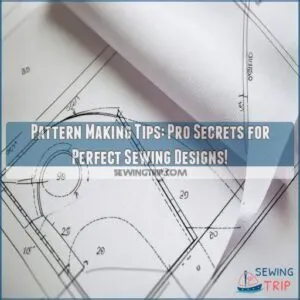
Start by investing in quality tools like flexible tape measures, French curves, and transparent rulers. Digital software can be a game-changer, but mastering manual techniques is essential.
Focus on precise measurements for bodice, skirt, and sleeve blocks—they’re your design foundation. Practice dart manipulation and understand how different fabrics behave.
Don’t rush; take your time tracing lines, marking grainlines, and checking measurements. Pattern making is part science, part art.
Every imperfection teaches you something new. Curious about turning those rough sketches into pro-level designs?
Table Of Contents
- Key Takeaways
- Essential Tools for Pattern Making
- Mastering Basic Blocks and Slopers
- Creating a Working Pattern
- Modifying and Adjusting Patterns
- Perfecting Skirt Patterns
- Mastering Sleeve and Collar Patterns
- Working With Smooth Lines and Darts
- Verifying Pattern Accuracy and Fit
- Efficient Pattern Making Techniques
- Advanced Pattern Making Strategies
- Frequently Asked Questions (FAQs)
- Conclusion
Key Takeaways
- You’ll master pattern making by investing in quality tools like flexible tape measures, French curves, and transparent rulers, which are critical for transforming design concepts into precise garment blueprints.
- You’ll unlock professional-level patterns by understanding fundamental techniques like dart manipulation, strategic pattern adjustments, and learning how different fabrics behave and drape.
- You’ll create custom-fit designs by taking accurate body measurements, developing basic blocks for bodice, sleeve, and skirt patterns, and practicing multiple iterations to perfect your technique.
- You’ll elevate your pattern-making skills by embracing digital and manual tools, experimenting with different pattern variations, and continuously learning through practice, prototyping, and creative problem-solving.
Essential Tools for Pattern Making
You’ll need a solid toolkit to transform your pattern-making dreams into reality, starting with precision measuring tools and drafting essentials.
Whether you’re a beginner or a seasoned pro, having the right equipment—like flexible tape measures, French curves, and quality pattern paper—will make your sewing design journey smoother and more professional.
Digital Pattern Making Software
Want to level up your pattern design game?
Digital pattern making software like Adobe Illustrator and Valentina open up pro-level creativity.
Free trials let you test software reviews and tutorials before investing.
Compare file formats, collaboration tools, and features that match your skill level.
Whether you’re a beginner or seasoned designer, the right digital platform can transform your pattern making journey.
Explore the best software options available at best software platforms to find the perfect fit for your needs.
Manual Pattern Making Tools
After exploring digital solutions, let’s get hands-on with manual pattern making tools.
Your drafting toolkit is your creative arsenal.
Grab those French curves, tracing paper, and a sharp set of fabric shears. Quality cutting mats and transparent rulers become your best friends.
These classic drafting tools aren’t just supplies—they’re your passport to transforming flat fabric into wearable art. Manual pattern making tools.
Quality Measuring Tools
A seamstress’s toolkit isn’t complete without precision measuring tools that become your silent partners in pattern making.
Your flexible tape measure is the MVP, hugging curves and capturing exact body measurements with surgical accuracy.
Transparent rulers and professional drafting tools transform guesswork into mathematical precision, ensuring your patterns fit like a second skin.
Tracing Wheels and Self-Healing Mats
A reliable tracing wheel and self-healing mat are your secret weapons in pattern making.
Pro drafting tools like Olfa and Dritz make cutting precise and smooth.
Your mat protects surfaces while preserving wheel edges, ensuring clean pattern lines.
Store mats flat, rotate cutting positions, and replace when the surface becomes visibly worn to maintain excellent performance in your sewing space.
Mastering Basic Blocks and Slopers
You’ll discover the foundation of pattern making by mastering basic blocks and slopers.
Transforming flat fabric into perfectly fitted garments.
With precise measurements and strategic techniques, you’ll learn to create custom pattern pieces.
That’ll turn your sewing projects from amateur to professional.
Bodice Block Creation
Got your measuring tape ready? Crafting bodice blocks starts with precision measurements that become your sewing blueprint.
Accurate shoulder width, bust, and back measurements are your secret weapons for perfect fit.
Learn dart placement tricks to transform flat fabric into three-dimensional magic.
Your foundation pattern isn’t just lines—it’s the roadmap to your dream design.
Skirt Block Development
Every skirt pattern starts with a solid foundation.
Your skirt block becomes the blueprint for endless design possibilities, tracking precise measurements from waist to hip.
Dart placement transforms flat fabric into curves, creating smooth lines that hug or flow.
Master size grading techniques to adapt your slopers for different body types, and you’ll reveal the secret to perfectly fitted skirt patterns every time.
Sleeve and Collar Block Construction
Your sleeve and collar blocks are the architectural blueprints of garment design, transforming flat fabric into three-dimensional wearable art. Mastering these fundamental pattern-making elements requires precision and creativity.
- Feel the thrill of transforming geometric shapes into living, breathing design
- Discover the secret language of pattern cutting techniques
- Conquer fitting challenges with surgical-like accuracy
- Experience the freedom of custom sleeve and collar variations
Pants and Shorts Block Pattern
After sculpting sleeve patterns that hug curves like a fitted jacket,
we’ll crack the code on pants and shorts block patterns.
Measuring hip, waist, and inseam becomes your roadmap to perfectly fitted bottoms.
Pro tip: Pocket placement and cuff options can transform basic patterns into custom designs that scream personal style. Pants adjustments aren’t rocket science—just precision and practice. perfectly fitted bottoms. custom designs
Creating a Working Pattern
You’ll transform your design vision into a tangible blueprint.
By creating a working pattern that captures every precise detail of your garment.
With careful measurements, strategic line drawings, and attention to grainlines and notches, you’ll construct a pattern that becomes the roadmap to your perfect sewing project.
Line Drawing and Pattern Development
Draft your line drawing with precision, like a cartographer mapping uncharted terrain.
Invest in the best drafting tools, such as those with curves and templates to help you achieve accuracy.
Accurate scaling transforms flat paper into wearable art, where smooth shifts and design variations become your playground.
Master drafting curves that flow like liquid silk, turning basic sketches into sophisticated pattern-making blueprints that breathe life into your creative vision.
Understanding Grainlines and Notches
The line drawing sets the stage, but grainlines and notches are your secret weapons in pattern making.
These tiny markers are like roadmaps guiding fabric assembly.
Align grainlines parallel to fabric threads to guarantee perfect drape and movement.
Strategic notch placement becomes your compass, helping pattern pieces snap together like puzzle parts, preventing sewing headaches down the line.
Adding Seam and Hem Allowance
Right from the get-go, seam and hem allowances can make or break your sewing project’s fit and finish.
- Standard seam allowance typically runs 5/8 inch wide
- Vary allowances based on fabric weight and garment type
- Use tracing wheels to mark consistent allowance lines
- Add extra ease for movement and comfort
Nail these techniques, and you’ll transform flat patterns into perfectly fitted garments.
Balance Points and Design Info
Symmetry breathes life into your pattern, with balance points serving as the secret sauce of design details.
Mastering these pivotal markers guarantees your garment drapes perfectly, transforming flat paper into a three-dimensional masterpiece.
Strategically place these points to navigate pattern ease, control fit adjustments, and open up endless style variations in your pattern making journey.
Modifying and Adjusting Patterns
You’ll learn how to transform your basic patterns into custom-fit designs that showcase your unique style and body shape.
Master the art of pattern modification by understanding dart manipulation, sleeve and collar adjustments, and fabric-specific alterations.
That’ll take your sewing projects from basic to brilliant.
Basic Pattern Adjustments and Alterations
After nailing your working pattern, you’ll want to master basic adjustments that transform good designs into perfect fits.
Bust adjustments, sleeve length tweaks, and waist shaping aren’t rocket science—they’re simple tweaks that make your garments sing.
Shoulder slope corrections and hem alterations can turn a so-so pattern into a custom-made masterpiece that hugs your curves just right.
Dart Manipulation Techniques
When you’ve got pattern adjustments down, dart manipulation becomes your secret weapon.
Think of darts as your sculpting tools – they transform flat fabric into three-dimensional magic.
Pivot, slash, and spread techniques let you reshape patterns like a pro.
Learn to manipulate dart locations, reduce bulk, and create smooth curves that hug your body perfectly.
Changing Sleeve and Collar Styles
Ready to shake up your pattern game? From bell sleeves to V-neck collars, sleeve variations and collar options are your ticket to design freedom.
Pivot those basic blocks with confidence!
By mastering pattern manipulation techniques, you’ll transform simple patterns into eye-catching styles.
Pro pattern making tips let you customize every detail, turning standard designs into your unique fashion statement.
Adapting Patterns for Different Fabrics
Sleeve variations set the stage for fabric-specific pattern magic!
Mastering pattern adjustments means understanding how different textiles behave and having a good grasp of pattern grading techniques.
Knit fabrics demand 10-20% size reduction, while woven materials require precise grain alignment to prevent distortion.
A good understanding of stretch factor also influences overall garment fit, and a shrinkage allowance prevents unexpected sizing surprises.
Drape determines final silhouette and movement.
Perfecting Skirt Patterns
You’ll transform flat patterns into stunning skirts that hug your curves or flow with graceful movement as you master the art of skirt pattern creation.
Whether you’re aiming for an A-line, pencil, circle, or asymmetrical design, you’ll learn the precise techniques to draft patterns.
that turn your sewing dreams into wearable masterpieces.
A-Line and Pencil Skirt Patterns
Your A-line and pencil skirt patterns are your canvas for creating killer silhouettes that hug every curve just right.
Master dart placement like a pro, experimenting with strategic positioning to transform flat fabric into stunning shape-defining designs.
Fabric choices make or break your pattern – lightweight wools and stable knits work magic for these sleek skirt styles.
Circle and Flared Skirt Patterns
Crafting circle and flared skirt patterns** transforms flat fabric into swirling masterpieces of design. These dynamic skirt styles demand precision and creativity in pattern making.
- Master radius measurements to create perfect circular flow
- Calculate waist size for seamless fitting
- Understand fabric drape and weight implications
- Experiment with hem variations for unique silhouettes
Pattern grading becomes your secret weapon in creating skirt patterns that dance with movement and style.
Tiered and Ruffled Skirt Patterns
Ready to amp up your skirt game with tiered and ruffled designs? From circle skirts to layered wonders, these patterns transform flat fabric into dynamic silhouettes.
To guarantee a stunning outcome, remember to take accurate measurements (https://sewingtrip.com/how-to-sew-a-skirt/), including your waist circumference and desired skirt length.
Master gathering techniques by calculating horizontal sections, strategically placing ruffles, and understanding fabric choices.
Play with pattern manipulation to create volume, control fullness, and nail those eye-catching design variations that make your skirt pop. Master gathering techniques and accurate measurements are key to success. Pattern manipulation will help you achieve the desired look.
Asymmetrical and High-Low Skirt Patterns
After conquering tiered skirts, let’s break free from traditional hemline constraints with asymmetrical and high-low skirt patterns.
Pattern manipulation opens doors to innovative design ideas.
Experiment with varied fabric choices to create dramatic length differences.
Sketch multiple hemline variations, playing with diagonal lines and unexpected curves.
Master these sewing techniques to transform simple skirt patterns into statement pieces that turn heads.
Mastering Sleeve and Collar Patterns
You’ll transform flat fabric into wearable art by mastering sleeve and collar patterns.
Turning basic measurements into stunning design elements.
With the right techniques, you’ll learn how to create cap, bell, raglan, Peter Pan, and crew neck styles.
These styles elevate your sewing projects from homemade to professional-grade.
Basic Sleeve Block Creation
Want to discover the secret to perfect sleeves?
Mastering the basic sleeve block starts with precise measurements of your bicep circumference, sleeve cap height, and width.
These key dimensions are your roadmap to creating sleeve patterns that fit like a glove. Grab your measuring tape and get started with the foundational skills of pattern drafting that’ll transform your sewing game. perfect sleeves and pattern drafting.
Cap, Bell, and Raglan Sleeve Styles
Building on your basic sleeve block, you’ll now discover sleeve variations that transform ordinary garments into standout pieces.
Cap, bell, and raglan styles each bring unique design details to your pattern making toolkit.
Mastering these sleeve adjustments helps you solve fitting issues and add personality to your sewing patterns, giving you the creative freedom to craft truly custom garments. sleeve variations and pattern making toolkit.
Peter Pan, Pointed, and Crew Neck Collar Patterns
Almost every collar tells a story, and mastering Peter Pan, pointed, and crew neck patterns opens your design creativity.
Your collar patterns need precise measurements and careful interfacing choices.
Trace your basic block, then transform it using strategic pattern grading techniques.
Understanding neckline finishes helps you create professional-looking collars that elevate your sewing patterns from basic to brilliant.
Working With Smooth Lines and Darts
You’ll transform flat fabric into stunning 3D shapes by mastering smooth lines and strategic dart placement.
Learn how to manipulate darts through pivoting, slashing, and spreading techniques.
to create professional-looking patterns that hug your body’s natural curves.
Creating Smooth Curves and Lines
Mastering smooth curves transforms your pattern making from amateur to professional. French curves are your secret weapon for creating flawless lines in pattern drafting.
- Use a French curve to trace precise, flowing lines
- Adjust your drafting angle for consistent curve accuracy
- Practice light, controlled tracing movements
Accurate grading and gentle curve manipulation separate good patterns from great ones.
Dart Manipulation and Rotation Techniques
After crafting smooth pattern lines, you’ll want to master dart manipulation – your secret weapon for transforming flat fabric into stunning 3D shapes.
Pivot techniques let you reshape darts strategically, creating elegant contours that hug curves perfectly.
Think of dart rotation like a magic wand that breathes life into your patterns, giving you total control over garment fit and design.
Mastering techniques like full bust adjustment can elevate your pattern-making skills and guarantee a flawless fit.
Slash and Spread Methods for Dart Rotation
Dart manipulation gets a creativity boost with slash and spread techniques that transform flat patterns into sculptured designs.
By carefully slashing pattern pieces from a pivot point, you’ll expand or contract fabric sections, creating unique silhouettes.
To take your designs to the next level, explore products suited to slash and spread patterns at products for slash and spread patterns.
This method lets you play with volume, reshape darts, and add design intrigue while maintaining precise pattern integrity.
Verifying Pattern Accuracy and Fit
You’ll want to verify every detail of your pattern before cutting into expensive fabric—a small mistake can turn your dream design into a sewing nightmare.
Checking pattern accuracy involves measuring twice, comparing seam lines, confirming grainlines, and marking critical points like darts with precision.
To guarantee your final garment fits perfectly.
Checking Pattern Pieces and Seam Allowance
From manipulating smooth lines, you’ll now zero in on checking pattern pieces with laser-sharp precision.
Your seam allowance can make or break a garment’s fit and finish.
Here’s what’ll help you nail it:
- Feel the power of accurate cutting
- Catch sneaky pattern adjustment pitfalls
- Prevent fabric shrinkage disasters
- Master seam allowances like a pro
Precision is your new sewing superpower.
Verifying Grainlines and Notches
Whether you’re a novice or seasoned designer, nailing grainlines and notches is your ticket to impeccable pattern making.
Carefully align pattern pieces along fabric’s lengthwise threads, ensuring grainlines accuracy for professional results.
Match notches precisely – these little alignment markers are your roadmap to perfect fabric positioning and seamless construction.
Tailor’s Tacks and Marking Darts
Right in between your pattern pieces, tailor’s tacks become your secret weapon for precise marking.
These clever little thread loops help you transfer critical dart locations and pattern details without leaving permanent marks.
Choose contrasting thread colors for visibility, and master different tack placement techniques across various fabric types to guarantee your sewing pattern comes together flawlessly.
Efficient Pattern Making Techniques
You’ll save time and boost your sewing skills by mastering efficient pattern making techniques that streamline your creative process.
With the right tools, smart strategies, and a bit of practice, you’ll transform pattern making from a complex task into an enjoyable and precise craft.
Using Pattern Weights and Notions
After checking those precise measurements, grab your pattern weights to keep tissue paper from dancing around.
Pro sewing tip: Ceramic, metal, and magnetic weights prevent slipping better than anything else. DIY enthusiasts can even craft custom pattern weights from smooth stones or heavy washers.
Keep your notions organized in compact containers for lightning-fast access during pattern making adventures.
Quality Paper for Pattern Making
When diving into pattern making, your paper choice can make or break your design’s precision. Remember that choosing the right paper is essential for accurate Mueller drafting system, as discussed in the guide to pattern drafting systems.
Here are five must-know paper selection tips:
- Invest in lightweight Swedish tracing paper for delicate drafting techniques
- Choose brown kraft paper for durable, eco-friendly pattern storage
- Use translucent pattern paper to easily trace and modify designs
- Select archival-quality paper for long-term pattern preservation
- Opt for medium-weight paper that holds crisp lines without bulk
Time-Saving Tips for Pattern Making
Already mastered quality pattern paper? Now kickstart your pattern making efficiency with smart time-saving hacks.
Precut fabric in batch, reuse digital templates, and invest in quick tracing tools.
Snap photos of your sewing patterns for instant digital references.
Pro tip: Create master pattern pieces you can modify repeatedly, saving hours of tedious redrafting and keeping your creativity flowing smoothly.
Advanced Pattern Making Strategies
You’ve reached the next level of pattern making.
where creativity meets precision in transforming flat fabric into stunning, personalized designs.
Master advanced dart manipulation, pattern ease, and complex artistic techniques.
to realize your true potential as a pattern maker and elevate your sewing skills beyond the basics.
Understanding Pattern Ease and Fit
Every sewing pattern needs its own breathing room—enter the magic of pattern ease!
Understanding fit adjustments is your secret weapon for killer designs.
Consider these key ease allowances:
- Body movement space (1-4 inches)
- Fabric stretch considerations
- Comfort-driven design impact
Pro pattern makers know that mastering ease transforms basic slopers into show-stopping garments that hug your curves perfectly.
Advanced Dart Manipulation Techniques
Ready to discover the magic of dart manipulation?
Pivot techniques transform flat patterns into stunning 3D shapes that hug your curves perfectly.
Slashing and spreading darts lets you reshape patterns with surgical precision.
Master dart rotation like a pro – it’s your secret weapon for creating garments that look custom-tailored, not off-the-rack.
Creating Artistic and Complex Patterns
After mastering dart manipulation, you’re ready to spark your creativity with artistic pattern making.
To refine your skills, consider customizing your designs with a variety of fabric types, each requiring adjustments for weight, stretch, and drape.
Push beyond basic blocks by experimenting with draping techniques that transform 3D effects into intricate design details.
Unusual fabrics become your canvas, where pattern grading meets imaginative drafting.
Learn to sculpt fabric like a designer, turning standard patterns into unique wearable art that tells your story.
Frequently Asked Questions (FAQs)
How do I get better at pattern drafting?
Master pattern drafting by nailing precise measurements, and practicing basic blocks religiously.
Experiment with dart manipulation.
Study fabric behaviors, invest in quality tools, and sketch relentlessly.
Learn from mistakes and don’t fear creative pattern transformations.
What are the 5 steps in pattern making?
Uncover your pattern-making magic.
by measuring precisely, drafting your basic block,
adding design details, creating a muslin prototype,
and refining fit through careful adjustments.
You’ll transform flat fabric into wearable art with each strategic step.
How do you make the best pattern?
Craft the perfect pattern by taking precise body measurements.
Creating accurate basic blocks is also important.
Manipulating darts strategically is key.
Adding pattern ease is another crucial step.
Testing fit through multiple muslins with careful adjustments for fabric type and desired silhouette is essential for the perfect pattern.
What are the three principles of pattern making?
You’ll nail pattern making by focusing on three key principles: precise body measurements, understanding fabric behavior, and strategic ease allocation.
These fundamentals transform flat fabric into perfectly fitted, comfortable garments.
That look and feel amazing.
How do I draft patterns for unique body shapes?
Master unique body shapes by taking precise measurements.
Creating custom basic blocks.
Using dart manipulation techniques.
Adjust patterns through strategic slashing, spreading, and pivoting to transform flat patterns into personalized, perfectly fitted garments.
Can I create custom patterns without expensive software?
Laugh off pricey software!
Valentina, a free pattern-making tool, becomes your design sidekick.
Grab French curves, pattern paper, and measurement tape.
Your DIY pattern-drafting adventure starts now, without breaking the bank.
What are common mistakes in pattern scaling?
Beware of mindless measurement scaling!
Common pattern mistakes include ignoring fabric stretch.
Forgetting body ease is another common mistake.
Miscalculating proportional changes is also a problem.
Neglecting critical balance points that transform flat patterns into perfectly fitted garments is crucial.
How do professional designers approach pattern development?
Pros start with precise body measurements, create basic blocks, and carefully manipulate darts.
They test multiple iterations.
They use digital tools like Adobe Illustrator, and continuously refine patterns through extensive mockups and fabric prototyping.
Where can beginners learn advanced pattern making techniques?
You’d think pattern making is rocket science, but it’s not!
Jump into online courses like Dressmaking Academy, YouTube tutorials, and books by experts like Dennic Chunman Lo.
You’ll master advanced techniques faster than you can say "custom fit"!
Conclusion
Like a masterful chef perfecting a complex recipe, pattern making demands patience, skill, and continuous learning.
You’ve now discovered pro pattern making tips and tricks that transform rough sketches into professional designs.
Remember, every pattern tells a unique story—your journey from novice to expert starts with practice, precision, and passion.
Embrace each challenge, learn from mistakes, and soon you’ll create patterns that breathe life into fabric, turning your creative vision into wearable art.

